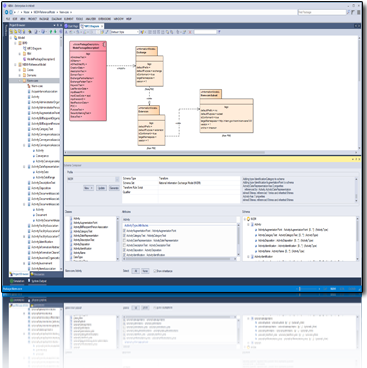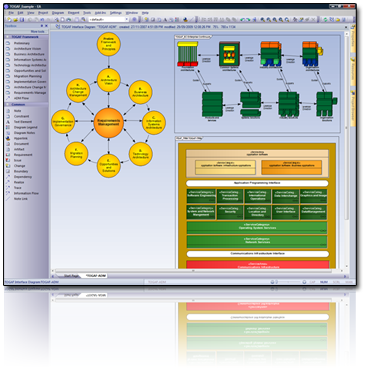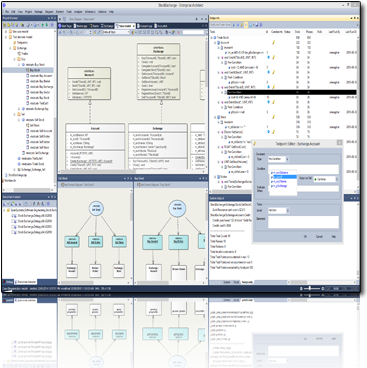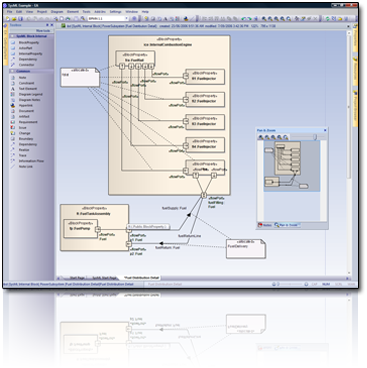 Enterprise
Architect
Enterprise
Architect


















With built-in requirements management capabilities, Enterprise Architect helps you trace high-level specifications to analysis, design, implementation, test and maintenance models using UML, SysML, BPMN and other open standards.
Enterprise Architect is a multi-user, graphical tool designed to help your teams build robust and maintainable systems. And using high quality, built-in reporting and documentation, you can deliver a truly shared vision easily and accurately!
Fast! Enterprise Architect users agree - Enterprise Architect is a spectacularly fast performer, loading extremely large models in seconds. Featuring a high-performance model repository, Enterprise Architect easily accommodates large teams sharing the same view of the enterprise.
With tightly integrated version control capabilities, and deployable cloud-based servers, Enterprise Architect also allows globally distributed teams to collaborate effectively on shared projects.
Bring your models to life using dynamic model simulation. Verify the correctness of your behavioral models and gain a better understanding of how a business system works. Use triggers such as pressing a button, flicking a switch or receiving a message to control the execution of your simulations. Enterprise Architect can also control the flow of your simulation using Guards and Effects written in JavaScript.
Guards determine which path will be taken next based on criteria such as when a valid password is entered. Take control of your simulations by using Effects to manipulate variables and perform calculations at specific times during a simulation. Experiment with different choices and make changes to your simulation in a risk averse environment. By controlling the speed of a simulation, you can slow a system down to observe previously unseen steps.
Use breakpoints to analyze decision making and improve business outcomes. Simulation can help to improve communication, convey essential business ideas and reduce complexity.
Enterprise Architect provides complete traceability from requirements, analysis and design models, through to implementation and deployment. Effective verification, validation and immediate impact analysis are possible across the entire life cycle, using such capabilities as Enterprise Architect's Relationship Matrix and Hierarchy View.
Combined with built-in task and resource allocation, Project managers and QA teams are equipped with the right information to help deliver projects successfully.
Capture and trace formal requirements to design, build, deployment and beyond. Use impact analysis to trace proposed changes to original requirements. Build the right system.
Enterprise Architect's built-in requirements management features can be used to:
Enterprise Architect helps individuals, groups and large organizations model and manage complex information. By integrating and connecting a wide range of structural and behavioral information in visual form, you can build a coherent, verifiable model of what-is or what-will-be.
Tools built into Enterprise Architect that help you manage complexity include:
Enterprise Architect provides powerful document generation and reporting tools with a full WYSIWYG template editor. Generate detailed reports with the information you need in the format your company or client demands!
At the click of a button automatically produce HTML versions of your model for easy distribution over the Internet or your organization's intranet.
The built-in source code editor lets you quickly navigate from model directly to source code in the same environment. Code generation templates let you customize generated source code according to your company specifications.
Enterprise Architect supports generation and reverse engineering of source code for many popular languages, including:

National Information Exchange Model (NIEM) provides a common framework that is used to define how information can be shared between systems, government agencies and organizations.
Learn More: NIEM

Based on open standards like UML, BPMN and SysML. Supporting enterprise architecture frameworks like TOGAF and UPDM. Integrated custom tools to analyze and visualize running software. Advanced simulation, testing tools, team based repositories, version control and more.
Learn More: BPMN, SysML, TOGAF, UPDM, Simulation

Develop and visualize software. Test and verify correct behavior. Simulate processes. Set and manage test points. Debug and inspect executing software. Advanced simulation, testing tools, team based repositories, version control and more.
Learn More: Visual Execution Analysis

Able to dynamically simulate behavior and state models. Confirm process design. Specify triggers, events, constraints and more. Watch the wheels turn! Specify complex and large structural systems. Create and debug embedded solutions. Build custom domain specific solutions. Build your own domain specific modeling tools!
Learn More: Model Simulation
Enterprise Architect helps you visualize your applications by supporting reverse engineering of a wide range of software development languages and database repository schema.
Bring in complete frameworks and legacy systems from source code, jar files or even .Net binary assemblies! By importing frameworks and library code, you can maximize re-use and understanding of your existing investment.
Enterprise Architect supports advanced Model Driven Architecture (MDA) transformations using easy to edit transform templates.
You can quickly develop detailed solutions from abstract models. A single platform independent model (PIM) can drive generation of multiple platform-specific target solutions - providing a significant productivity boost!
With built-in transformations for:
Enterprise Architect enables you to build, test, debug, run and execute deployment scripts, all from within the Enterprise Architect development environment. With the ability to generate NUnit and JUnit test classes from source classes using MDA Transformations and integrate the test process directly into the Enterprise Architect IDE, you can now integrate UML and modeling into the build/test/execute/deploy process.
In addition to build/test and execute functionality, Enterprise Architect includes debugging capabilities for Java, .NET and Microsoft Native (C++, C and VB). The debuggers built into Enterprise Architect are specifically designed to enable a developer or tester to capture stack trace information as they 'walk through' the executing code, performing runtime inspection of suspended threads.
They can then use the final stack trace history to generate Sequence diagrams within Enterprise Architect, converting the actual code execution and calls into visual diagrams.
The Automation Interface lets you access the internals of Enterprise Architect models. Any development environment capable of generating ActiveX Com clients can be used to connect to Enterprise Architect's Automation Interface.
Some examples of tasks you could perform via the Automation Interface:
Enterprise Architect's built-in Data Modeling tools and profiles extend UML to provide an intuitive mapping from the database concepts of tables and relationships onto the UML concepts of classes and associations. These extensions also enable you to model database keys, triggers, constraints, RI and other relational database features.
Enterprise Architect supports modeling of database schema and automatic generation of DDL scripts for eleven DBMS targets out-of-the-box:
Integrating many high-end features for Systems Engineers, the Ultimate and Systems Engineering editions of Enterprise Architect provide built-in support for:
There are many approaches to Business Process Modeling (BPM) using UML as the base modeling language.
In particular, Activity diagrams, Object Diagrams and custom Profiles provide powerful modeling approaches for Business Analysts.
Enterprise Architect complements UML 2.5 with BPMN support and extension elements for analysis, requirements management and process management (such as change, feature and issue elements).
Enterprise Architect's Business Process Modeling capabilities let you:
Enterprise Architect's foundations are built upon the UML 2 specification - but it doesn't stop there!
Use UML Profiles to extend the modeling domain, while Model Validation ensures integrity.
Combine Business Processes, Information and Work Flows in the one model using our free extensions for BPMN and the Eriksson-Penker profile.
Project managers can use Enterprise Architect to:
Enterprise Architect's Use Case Metrics capability makes it easy to assess relative project complexity, based on the number and type of use cases within the model, the type of project and capabilities of the development environment.
With experience, use case metrics provide a great way to quickly assess the scope of a project.